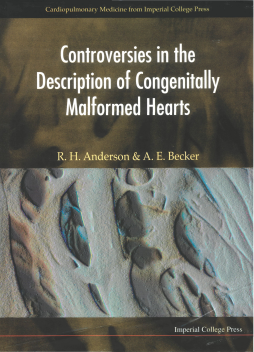
BOOK
Controversies In The Description Of Congenitally Malformed Hearts
Anderson Robert Henry | Becker Anton E | Williamson A
(1998)
Additional Information
Book Details
Abstract
This series of four video tapes, which is based on the demonstrations pre-recorded by Robert H Anderson and Anton E Becker, two prominent European morphologists, shows the essence of the abnormal morphology within carefully selected autopsy specimens, comparing the findings with appropriately dissected normal hearts, and supplementing the anatomic material with diagrams and cartoons. Accompanying these tapes is an explanatory book prepared with extensive full colour illustrations based on the specimens and diagrams used in the videos and supplemented by appropriate material from the extensive files of the authors.The introductory chapter of the book discusses the background to sequential segmental analysis and the importance of the morphological myocardial method of recognizing chambers and arterial trunks in congenitally malformed hearts. The book is also available without the videos.Videos and book together address such crucial questions as:∗ How many segments need to be considered within the heart?∗ Is the myocardial morphologic method the best way of recognizing chambers?∗ Is the atrioventricular junction a common structure in the ostium primum defect?∗ Is there such a thing as isomerism of the atrial appendages?∗ What is the univentricular atrioventricular connection — and are there really any univentricular hearts?∗ Is the infundibulum in tetralogy of Fallot too narrow, too shallow, and too short?To answer these, and many more questions, Anderson and Becker alternately act as devil's advocate in the four videos, each lasting approximately 40 minutes. The individual videos are devoted to:Video and Chapter Titles:∗ Atrioventricular septal defects∗ Hearts with isomeric atrial appendages∗ Tetralogy of Fallot and double outlet right ventricle∗ Hearts with univentricular atrioventricular connection
Table of Contents
| Section Title | Page | Action | Price |
|---|---|---|---|
| Contents | vii | ||
| Foreword | v | ||
| Chapter 1 Introduction | 1 | ||
| THE MORPHOLOGIC METHOD | 1 | ||
| SEQUENTIAL SEGMENTAL ANALYSIS | 11 | ||
| ONGOING CONTROVERSIES | 15 | ||
| REFERENCES | 16 | ||
| Chapter 2 Atrioventricular Septal Defects | 18 | ||
| STRUCTURE OF THE NORMAL ATRIOVENTRICULAR JUNCTIONS AND THE MITRAL VALVE | 21 | ||
| THE ESSENTIAL FEATURES OF ATRIOVENTRICULAR SEPTAL DEFECT WITH COMMON JUNCTION | 30 | ||
| ANATOMIC VARIANTS | 43 | ||
| THE RASTELLI CLASSIFICATION | 49 | ||
| THE LEFT ATRIOVENTRICULAR VALVE | 55 | ||
| THE ATRIOVENTRICULAR CONDUCTION AXIS | 58 | ||
| HEARTS WHICH ARE NOT ATRIOVENTRICULAR SEPTAL DEFECT WITH COMMON JUNCTION | 59 | ||
| DEVELOPMENTAL CONSIDERATIONS | 61 | ||
| CONCLUSIONS | 64 | ||
| REFERENCES | 65 | ||
| Chapter 3 Isomerism of the Atrial Appendages | 67 | ||
| INTRODUCTION | 67 | ||
| SYMMETRY VERSUS LATERALIZATION | 68 | ||
| MORPHOLOGY OF THE ATRIUMS RELEVANT TO ISOMERISM | 76 | ||
| MORPHOLOGY OF HEARTS WITH ISOMERIC ATRIAL APPENDAGES | 85 | ||
| SYNTHESIS OF FINDINGS | 106 | ||
| DEVELOPMENTAL CONSIDERATIONS | 107 | ||
| REFERENCES | 110 | ||
| Chapter 4 Tetralogy of Fallot | 113 | ||
| INTRODUCTION | 113 | ||
| UNIFYING PATHOLOGY | 115 | ||
| VARIATIONS IN THE CHARACTERISTIC ANATOMY | 131 | ||
| CONTROVERSIAL ASPECTS | 141 | ||
| The right ventricular outflow tract or infundibulum | 141 | ||
| Fallot's tetralogy versus double outlet right ventricle | 143 | ||
| DEVELOPMENTAL CONSIDERATIONS | 145 | ||
| REFERENCES | 146 | ||
| Chapter 5 Hearts with Univentricular Atrioventricular Connection | 149 | ||
| INTRODUCTION | 149 | ||
| THE ATRIOVENTRICULAR JUNCTIONS | 150 | ||
| DESCRIPTION OF VENTRICULAR MORPHOLOGY | 163 | ||
| THE UNIATRIAL BUT BIVENTRICULAR CONNECTION | 177 | ||
| THE OVERALL NATURE OF THE VENTRICULAR MASS | 178 | ||
| DEVELOPMENTAL CONSIDERATIONS | 188 | ||
| REFERENCES | 193 | ||
| Index | 195 |
